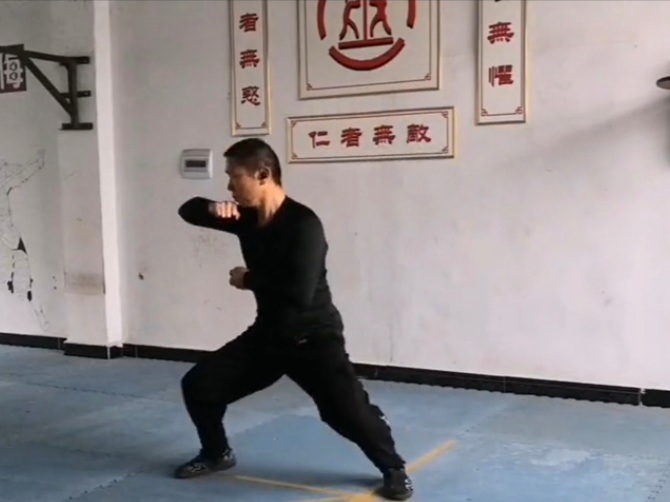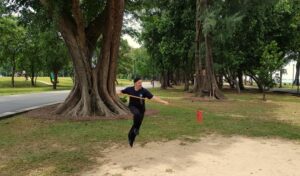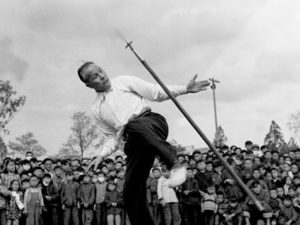Wu Jia Quan, or Wu (巫) Family Boxing is one of the most famous martial arts from Hubei and Hunan Province in South China. During the Qian Long emperor’s reign (1736-1795) of the Qing Dynasty, a Master Wu Bida (巫必达) who was from Liangcheng in Fujian province after acquiring knowledge of martial arts developed his new approach and system that emphasized compact or small frame of movements and techniques where the power is not evident from the exterior and the practice interlinks in a continual fashion, without any specific pausing. The movements are not acrobatic and the emphasis is on the hands or upper limbs to execute.
Wu Bida (巫必达, 1751~1812), also known as Wu Youneng, nicknamed Wu Hei, was from the Liancheng area of Fujian province and had later settled in Hubei and Hunan Province. He had studied martial since a young age with the Fujian Taizu Quan Fa Master Ming Ru. Later when in his teens he travelled to neighbouring Zhejiang and Jiangxi provinces including gaining the friendship of many martial artists. It is said that his interaction with the Wudang Neijiaquan styles added elements of a softer approach into his martial arts which he later developed into his own boxing method that he propagated in Hunan Province when he settled there. The style became known after his family name as “Wu Family Boxing”.
The style was practiced amongst villagers of the Xiangtan and neighbouring counties and the origins were not understood until the 1970’s when a 7th generation descendant Master Peng Jianjia told of a story. It was that at the time whilst crossing a river an accident had occured and Wu Bida had broken a leg saving a father and his young son. On the same river crossing five others were looking at Wu Bida and tempted to try and steal from him thinking that as his leg was injured it would be an easy task. The result as told by the Father and son was that Wu Bida raised his hands and with an unbelievable skill killed one of the assailants immediately, another was struck with an elbow and knee lying unconcious and the third push into the river. The remaining two managed to run away. From this ocassion Wu Bida became renowned that even as crippled legged master this did not inhibit the passing of the great martial skills and the essenced of Wu Jia Quan was taught to many villagers to protect their families. When he resided in the home of Li Dakui, in Zhuzhou, Hubei province – he taught Li Dakui and some disciples including the brothers Feng Nanshan and Feng Lianshan who were from Xiangtan in Hunan province. There the style was practiced and passed on until the 7th generation today which most descend from either the Li or Feng families.
Features and Characteristics
Wu Jiaquan is characterised by close quarters combat, short striking, continuouity of technique and specialises in calmness to overcome adversity, using gentleness to defeat hardness which are similar concepts to the Wudang or Taijiquan styles in theory. However resulting from the southern boxing basis that Wu Bida had, the style actually has unique features and approaches where there are bridge methods in addition to those of adhering and power borrowing common to the Neijiaquan styles. Therefore the techniques of Wujiaquan share much in common with southern boxing systems (although their execution is highly differentiated by the softer/internal principles).
Some of the hand methods include – Pan Quan (Pulling Fist), Guan Yang Quan (Piercing Sun Fist), Shuang Fei Zhang (Double Flying Palms), Pao Quan (Cannon Fist), Zhi Ca Zhang (Straight Rubbing Palm), Ta He Zhang (Collapsing Palms), Lie ma Lian Zhu Shou (Stringed Hands) and Lei Jiao Zhou (Angled Elbow) as examples. Wu Jia Quan is often refered to as ” Qi Quan, Liu Zhou, Shi Er Zhang” (7 Fists, 6 Elbows, 12 Palms).
Wu Jia Quan heavily emphasises the 6 elbows. These so called 6 elbows are : Zhuang Zhou (Bump Elbow), Yao Zhou (Shake the Elbow), Bian Zhou (Flat Elbow), Lei Zhou (Grinding Elbow), Ge Zhou (Placed Elbow) and Dun Zhou (Moving Elbow). Essentially Zhuang Zhou is a linear elbow, Yao Zhou is on the Horizontal plane, Bian Zhou is with a hollowed in body elbow in the horiziontal plane, Lei Zhou is an upward elbow on the vertical plan, Ge Zhou (also known as Gai Zhou) is a downward elbow on the vertical plane and finalling Dun Zhou (also known as Jiao Zhou) is used in extreme close quarters which is angled and also co-ordinates with the shoulder and hands to function.
In terms of the stances and footwork, a unique aspect is the very upright posture of the style which includes Meihua Bu (Plum Blossom Stance) as the the fundamental, as well as Zi You Zhuang (Free Stance) and San Cha Bu (3 Fork Stance). Since Wu Jia Quan emphasises close quarter combat, most of its power generating methods emphasise inch power, but the neutralizing aspects of the style also call for a such transformational power. The combination in balance are often referred to as the changes of Yin Yang powers in the style.
The forms of Wu Jia Quan include the following:
- San Cha Liu Zhou (3 Forked Six Elbows)
- Qia Diao Liu Zhou (Single Kicking Methods)
- Qi Lin Liu Zhou (Unicorn Six Elbows)
- Bai Men Liu Zhou (Swinging Six Elbows)
- Tian Zi Liu Zhou ( ‘ 田’ Character Six Elbows)
- Qi Xing Liu Zhou (Seven Stars Six Elbows)
- Dan Diao Liu Zhou (Single Hanging Six Elbows)
- Zheng Ping Liu Zhou (Straight Level Six Elbows)
- Yinyang Chujin Lianhuan Shou (Yin Yang outgoing and incoming continuous hands)
- Tan Li Xin Yi Quan (Search for power, Intention Fist)
Weapons practiced include :
- Wu Jia Qi Bu Lian Zhen Gun (Wu Family 7 Step Linked Poking Staff)
- Wu Jia Ban Deng (Wu Family Bench)
- Wu Jia Dan Dao (Wu Family Broadsword)
- Da Pa (Large Rake)
- Shuang Jian ( Double Mace)
- Da Pa (Large Rake)
- Gou Lian Qiang (Hook tipped Spear)




![Read more about the article Yanqing Quan – Yanqing Jiazi [燕青门 – 燕青架子]](http://taipinginstitute.com/wp-content/uploads/2021/08/vfdvfdvfdasv_n-235x300.jpg)